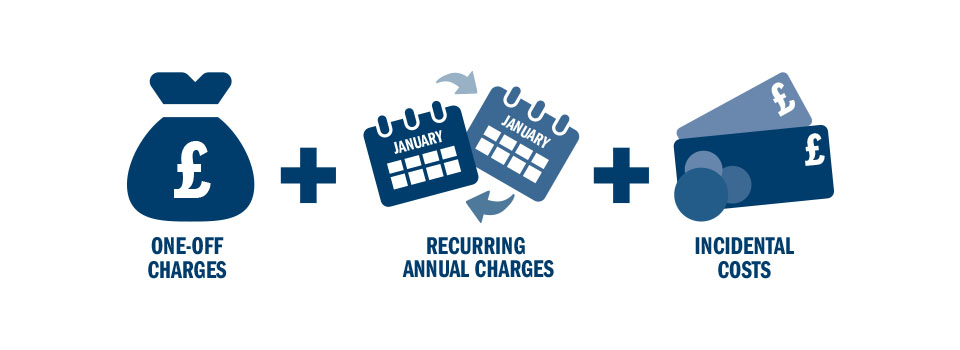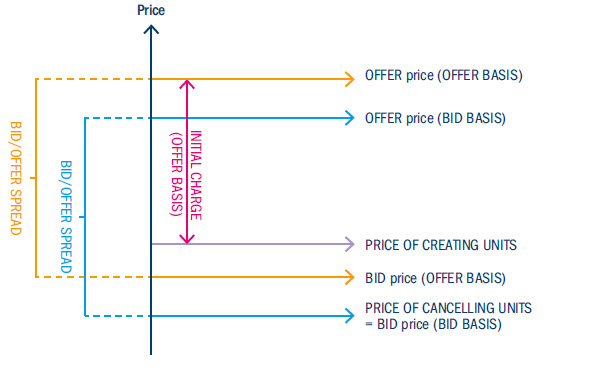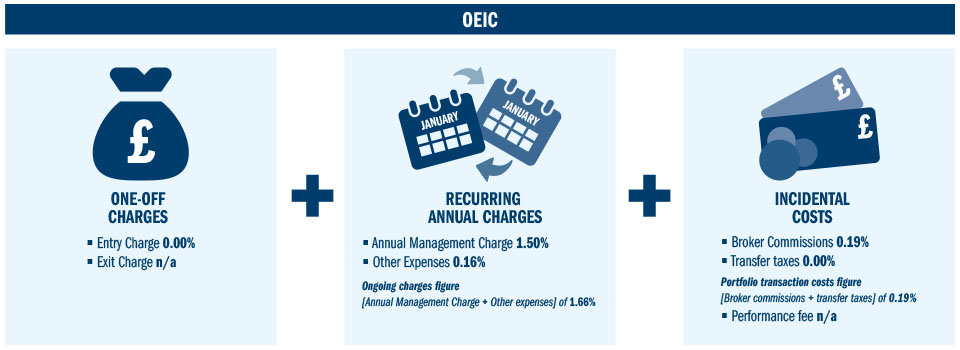Fund Charges and Costs Explained
There are a number of charges and costs that are incurred when you invest. The charges that you pay are used to cover the costs of running the fund, including our charge for managing the fund. These charges are taken directly from the assets of the fund, and the value of your investment will be lower as a result.
Charges can vary from fund to fund and between share classes. Further information about specific charges can be found in the relevant Fund Prospectus and on the Funds and Prices page of the Columbia Threadneedle Investments website where you can search for your fund by name/ISIN.
If you have any queries please contact us.
The links below allow you to see full descriptions for all charges relevant to the OEIC products. Please note that your investment may not be subject to all of these charges and costs and no investment decision should be made based on the information contained in the descriptions alone. If you are unsure about any investment decision you should contact a financial adviser.
The UK's Investment Association (IA) provides guidance and explanation regarding the costs associated with investing. For further information visit The Investment Association.
- Fund charges and costs explained
- One-off charges
- Annual charges
- Incidental costs
- Pricing policy of our UK fund range
- Numerical example
Fund charges and costs explained – Columbia Threadneedle UK domiciled fund range
There are a number of charges and costs that are incurred when you invest. The charges that you pay are used to cover the costs of running the fund, including our charge for managing the fund. These charges are taken directly from the assets of the fund, and the value of your investment will be lower as a result.
Charges can vary from fund to fund and between share classes. Further information about specific charges can be found in the relevant Fund Prospectus and on the Funds and Prices page of the Columbia Threadneedle Investments website where you can search for your fund by name/ISIN.
The total cost of your investment may comprise of the following:

One-off charges
Entry charge
Often referred to as an initial charge this is the maximum that may be taken from your investment before the deal is placed in your chosen fund.
Columbia Threadneedle Investments does not currently apply any entry charges on its UK domiciled fund ranges, but if you buy our funds through certain distributors they may apply an entry charge.
Exit charge
Often referred to as a redemption charge, this relates to the amount of money that may be taken from your investment before the proceeds of your investment are paid to you.
Columbia Threadneedle Investments does not charge exit fees.
Switching charge
This is a charge that may be incurred if you choose to switch from one share class or fund to another share class or fund.
Columbia Threadneedle Investments does not currently apply switching charges.
Please note: if you invest in our funds through a platform, you may incur charges from them.
Annual charges
There are a number of charges and costs borne by the funds each year as described below.
Ongoing Charges Figure (OCF)
The OCF is an industry standard way of measuring the annual cost of investing in a fund. It is used to give a snapshot of how much it will cost to invest in the fund annually. It is based on the last financial year’s expenses and may vary from year to year. For newly launched funds, which do not have the previous year’s information to calculate the OCF, the figure is estimated.
The OCF includes most of the fees and charges incurred by the fund including the annual management charge, registration fee, custody fees and distribution cost but excludes any One-Off Charges (e.g. entry, exit or switching charges), Incidental Costs (e.g. performance fees) and Portfolio Transaction Costs (the costs of buying or selling assets for the fund).
The following are the main elements of the OCF:
- Annual management charge (AMC)
This is a charge paid annually to Columbia Threadneedle Investments for managing your investment in a fund.
- Registration fee
This is a fee paid in return for Columbia Threadneedle paying or satisfying certain ongoing registration and general expenses. At any particular time the actual amount of ongoing registration and general expenses may be more or less than Columbia Threadneedle Investments collects from the fund.
The following form part of the registrar fee: - fees and expenses in respect of establishing and maintaining the register of Shareholders and related functions including the fees of the registrar;
- expenses incurred in distributing income to Shareholders;
- fees in respect of the publication and circulation of details of the Net Asset Value and prices;
- fees and expenses of tax, legal and other professional advisers of Columbia Threadneedle;
- costs of convening and holding Shareholder meetings (including meetings of Shareholders in any particular fund, and a particular class within a fund);
- costs of printing and distributing reports, accounts and any prospectus, publishing prices and any costs incurred as a result of periodic updates of any prospectus and any other administrative expenses;
- fees connected with the listing of Shares on the Stock Exchange; and
- Report & Account fees
- Custody (Safe keeping) fee - fee charged by the Depositary and Custodian who are the legal owners of the funds’ property and are responsible for safe keeping of the assets.
- Custody transaction fee - transaction expenses incurred by the Depositary and Custodian who are the legal owners of the funds’ property and are responsible for safekeeping of the assets.
- Audit fee - fees and expenses of the funds' Auditors.
- Regulatory fee - fees of the Financial Conduct Authority and the corresponding periodic fees of any regulatory authority in a country or territory outside the United Kingdom in which Shares are or may be marketed.
OCF example:
If you have £1,000 invested in a fund with an OCF of 1.45% – we will deduct £14.50 from your investment each year to cover these costs and charges.
Incidental costs
There are further incidental annual charges and costs that are not part of the OCF, but will, should they arise, be paid out of the fund:
Portfolio transaction costs (PTC)
This includes the expenses that arise from selling or buying investments in the fund, including redemption fees, transfer fees and broker commissions. Costs for a property fund may be significantly higher than an equity or bond fund, due to the additional transaction costs associated with buying or selling property.
Please note that the Portfolio Transaction Costs likely to be incurred as a result of large subscription/redemption requests are factored into the Dilution levy/adjustment rates applied to these deals.
If you are invested in a fund that invests in other funds there will be costs associated with the underlying funds. For detail of how this works, please consult the Prospectus.
Property Expense Ratio (PER)
There are a number of costs related to running and maintaining property funds that are not covered as part of the Ongoing Charges Figure (OCF). These additional costs are grouped together to form the Property Expense Ratio (PER), which includes:
- Non-recoverable property management fees
- Service charge shortfalls and holding costs such as empty rates and security
- Rent review and lease renewal costs
- Maintenance and repairs (not improvements)
- Property insurance costs/rebates
- Amortised debt- financing fees/costs
- Debt valuation fees
- Marketing of vacant space
- Project management fees (where not capitalised)
The costs associated with the Property Expense Ratio apply to the following OEIC funds:
- Threadneedle UK Property Authorised Investment Fund (Threadneedle PAIF)
- Threadneedle UK Property Authorised Trust (Threadneedle PAIF Feeder Fund)
Pricing policy of our UK fund range
Funds can be either single or dual-priced. A single-priced fund is bought and sold at the same price, subject to a potential dilution adjustment (please see definition below).
Dual-priced funds have an offer price at which you buy, and a lower bid price, at which you sell.
View full list of funds within each range
This table shows the pricing policy for our UK domiciled fund range.
| Fund range | Pricing policy |
|---|---|
| Threadneedle Investment Funds (TIF) | Single-priced with potential Dilution Adjustment |
| Threadneedle Specialist Investment Funds (TSIF) | Single-priced with potential Dilution Adjustment |
| Threadneedle Opportunity Investment Funds (TOIF) | Single-priced with potential Dilution Adjustment |
| Threadneedle UK Property Authorised Investment Fund | Dual-priced |
| Threadneedle UK Property Authorised Trust (feeder fund) | Dual-priced |
Single-priced funds
Dilution adjustment
A single-priced fund has one price at which investors both buy and sell shares/units in a fund in the same dealing period.
When a fund buys or sells investments it incurs certain transactional costs. For this reason, our singlepriced funds reserve the right to apply a dilution adjustment, in order to protect investors from the impact of transactional costs arising from large scale movements into or out of a fund.
Funds that operate a dilution adjustment will adjust the fund’s price if required to protect your investment from the impact of other investors joining or leaving the fund.
The amount of any dilution adjustment is calculated by reference to the estimated cost of dealing in the underlying investments. The estimated percentage impact of these adjustments is detailed in the prospectus for each fund.
Dual-priced funds
With dual-priced funds, there is a separate price for buying and selling shares/units in a fund. The difference between the buying (offer) and selling (bid) price is known as the bid-offer spread.
The bid-offer spread broadly comprises the initial charge plus the difference between the buying and selling prices of the underlying investments plus any other costs involved in buying or selling the underlying investments.
The operation of dual-pricing means that when investments are bought or sold as a result of other investors buying into or selling out of the fund your investment is sheltered from the costs of these transactions.
For our property funds (Threadneedle PAIF and its Feeder Fund), dual-pricing operates slightly different, in order to operate a narrower bid/offer spread for clients; to mitigate the high cost of transacting in property as an asset class.
For these property funds the buying (offer) and selling (bid) prices of the funds are generally dependent on whether the fund is experiencing more investors buying into rather than selling out of the fund (offer basis), or more investors selling out of rather than buying into the fund (bid basis).
Offer basis
When on offer basis, the fund’s price originates from the buying price of the underlying properties and any investments.
Buying (offer) price = price of creating a new unit (cost of buying underlying investment + plus any related costs) + any initial charge.
Selling (bid) price = buying (offer) price - the bid/offer spread
Bid basis
When on bid basis, the fund’s price originates from the selling price of the underlying properties and any other investments.
Selling (bid) price = price of cancelling a unit (proceeds from selling the underlying investments) - any related costs
Buying (offer) price = selling price + the bid/offer spread.

It is not always possible to support a narrow bid-offer spread within our property funds (compared to the full costs of dealing in the underlying properties). In these circumstances, in order to protect existing investors from such costs, the management company may deal any large subscription or redemption requests at the creation or cancellation price, as appropriate.
Please note that if you invest through a platform, trades are aggregated. Consequently, all this may mean that several smaller deals are treated as a large deal.
Numerical example


For examples on the operation of Performance Fees for the applicable funds, please refer to the relevant Fund Prospectus.